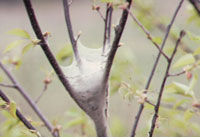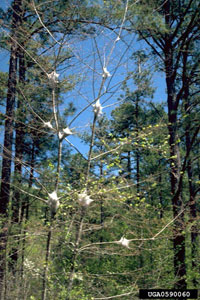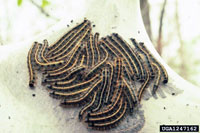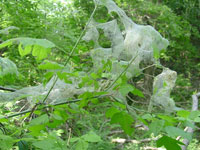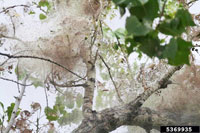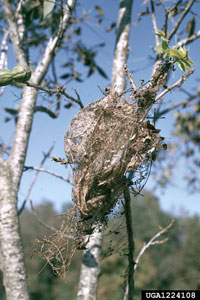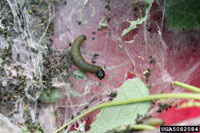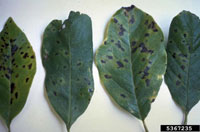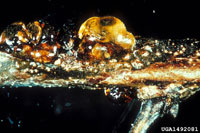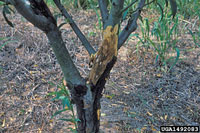Extension > Garden > Diagnose a problem > What's wrong with my plant? > Deciduous Trees > Prunus > Holes in leaves or parts of leaves missing
Prunus > Leaves > Holes in leaves or parts of leaves missing
1 of 6
Eastern tent caterpillar
Malacosoma americanum
- Larvae form webs at branch forks, congregating in web only to feed on young leaves
- In high populations, tree is covered in webbing and defoliated
- White stripe running length of black body with bright blue spots; almost 2 inches long
- Damage occurs in May and June
- More information on Eastern tent caterpillar
2 of 6
Fall webworm
Hyphantria cunea
- Chews entire sections of leaves, leaving major veins and can defoliate trees in high infestations
- Produces silken webbing that covers the ends of branches; silken tent filled with frass and leaf segments
- Yellowish or greenish with long, fine white hairs with two rows of black spots down its back; approximately 1" when fully grown
- Damage occurs from late July through September
- More information on Fall webworm
3 of 6
Japanese beetle
Popillia japonica
- Skeletonizes leaves, i.e. chews leaf tissue between the veins creating a lacelike appearance
- Adults are metallic green; bronze wings; white tufts of "hair" along their sides
- Beetles present as early as late June and active through September
- Feeds on 100's of different plant species, including gray birch
- More information on Japanese beetle
4 of 6
Uglynest caterpillar
Archips cerasivorana
- Larvae eat leaves and can defoliate branches
- Spin webs that become filled with frass and leaf pieces
- Up to 1 inch long; black head and yellowish to dark green body
- Cherry trees are preferred hosts
- More information on Uglynest caterpillar
5 of 6
Leaf spot
Blumeriella jaapii
- Purple to reddish brown spots that are up to 1/10th inch diameter
- Spots grow together, causing large parts of the leaf to turn brown
- Leaves with multiple spots turn yellow and fall off prematurely
- Leaf spots dry up and fall out, leaving holes in the leaf, leave appear to have shot holes
- Damage first seen in late spring, early summer
- More information on Leaf spot
6 of 6
Bacterial spot and canker
Pseudomonas syringae pv. syringae
- Angular, brown to black leaf spots that eventually drop out leaving holes and giving a ragged appearance on leaves
- Blossoms turn brown, especially after frost damage
- Sunken dark colored elliptical cankers form on branches
- Sticky gums (gummosis) or sour-smelling liquid are excreted from infected branches
- More information on Bacterial spot and canker



